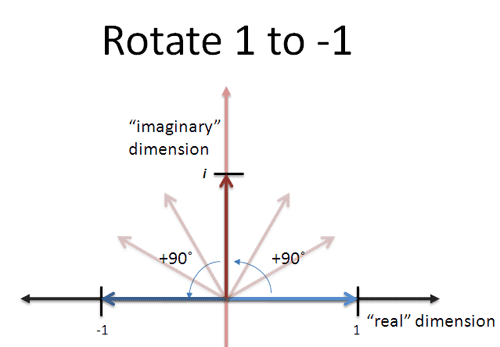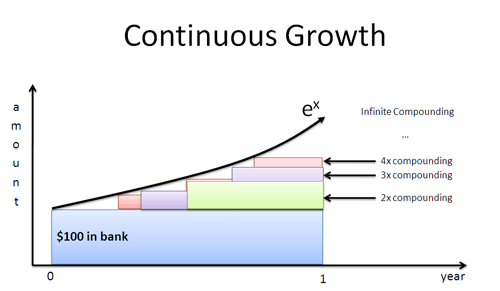The names we use determine how easily a concept clicks. Mathematicians struggled with the idea of a "negative" number. It's not there, but not zero either? It's somehowlessthan nothing?
You'll spin yourself dizzy trying to reconcile the ideas. So just rename it:
那么“向前”和“向后”数字呢?
The invention of the number linevastlyimproved our understanding. What is "backwards from backwards"? It's forwards again! (I.e., why negative x negative = positive — morevisual arithmetic.)
What is "halfway backwards"?Sideways!

错误的话语限制了我们的思想。
That this subject [imaginary numbers] has hitherto been surrounded by mysterious obscurity, is to be attributed largely to an ill adapted notation. If, for example, +1, -1, and the square root of -1 had been called direct, inverse and lateral units, instead of positive, negative and imaginary (or even impossible), such an obscurity would have been out of the question. - Carl Gauss
Example: Counting
When we want a "count" of something, we aren't being specific enough. We're using too general a name.

There are two types of counts:
- The points that determine the boundaries
- The spans between the boundaries
Assuming there's a single, universal "count" sets ourselves up for off-by-one errors. Was that a "point count" or a "span count"?
“在计算机科学中有两件困难的事情:缓存失效、命名和偏一错误。”- Phil Karlton
Even the name "off by one" isn't that helpful. That's the symptom, but what's the root cause? The"Fencepost error"helps identify why the issue happened.
Example: Angles
How should we describe an angle? There's two ways to see it:
- Degrees, theswivelan observer went through to follow an object
- Radians, thedistancethe object moved on its path

When physics formulas (sine, cosine, etc.) ask for "angle in radians" they mean "distance the object moved". Aha!
(运动定律并不特别关心你,作为观察者,需要倾斜多少头。抱歉。)
Example: Integrals
积分通常被描述为微分的倒数,求曲线下的面积,等等。
How about this renaming:integrals are fancy multiplication.
That's it. You try to multiply two quantities, but you can't — one of the critters is scurrying around — so you use an integral.
"If I drive an unwavering 30mph for 3 hours, would just multiply it out. But since my speed changes, I'll integrate."
Think "fancy multiplication" not "inverse of differentiation". (Unless you're actually solving differential equations. In that case, have fun.)
Example: The Pythagorean Theorem
Most formulas are named after their inventor. It's good to give credit, but it's not helpful for the student. For the Pythagorean Theorem, there's a few alternate names we can try:
- Triangle Theorem已知直角三角形的两条边,我们可以知道第三条边。

- Distance Theorem: Get the distance between points in any number of dimensions. (By imagining they're on a sequence of triangles.)

- Tradeoff Theorem: Find the tradeoff as you move in any direction (how much "x distance" you give up to gain "y distance"). Using this, we canfollow the gradientfor the optimal direction.

如果你脑子里有正确的短语,数学就会变得容易得多。Just use the "distance theorem" for distance, the "tradeoff theorem" to find the best direction to move.
Even if you forget the formula, you know how it's applied. Otherwise, you have the phrase "Pythagorean Theorem" without the understanding of why you'd need it.
Example: The number e
A super-common question is "Why is the number e important"? It's all in the name.
e is the "universal growth constant" like c is the "speed of light constant". c is perfect speed (can't improve it further), e^x is perfect growth (can't compound it further).

e^x is what we see whencompounding 100% with no delay.为什么100%的?对称,宝贝:我们的生长速度和我们现在的数量相符。(Similarly, we do trig on the unit circle, use 1.0 as our base increment for counting, and so on.)
Once we have perfection, we can modify it for our scenario. Maybe are growing for more time periods, or at a different rate — that's fine, just modify e^x.
命名为“欧拉常数”并不能说明问题。“普遍增长常数”更有帮助。
Example: Matrix Multiplication
I'm on a linear algebra kick. Instead of "Matrix multiplication" (which is a very drab description of what we're doing), how about"running data through operations"(or "running a spreadsheet").

One matrix represents the operations, one matrix represents the data, and we are running the data through a pipeline.
Yes, insomecases you can think about "linearly transforming a vector space" but often times we're just transforming data.
如果有错误呢?不要说“你把它乘错了”(哎呀,谢谢),不如说“操作期望不同大小的数据”。啊!我知道该修什么。
Make Your Own Names
They never tell you how much easier math gets when you create your own names for things. I use whatever analogies, metaphors, or plain-English descriptions help. They may feel silly, but it's a much better feeling than confusion.
There's an ancient concept that knowing the name of thing gives you power over it. It seems to be true for math.
Appendix: Poincare on names
A famous mathematician had a great quote on naming:
"Mathematics is the art of giving the same name to different things." -Henri Poincare
Math often finds what things have in common (two birds, two fish => "twoness"). But to internalize a concept, we need several ways to describe the same thing. Use as many names as it takes: each is an antibiotic that can treat our confusion, and maybe one will stick.
Appendix: Cheatsheet
I have anintuition cheatsheet用许多概念的改写。

Hope you enjoy it!


